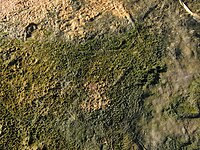
Photo from wikipedia
Abstract a series of acylphosphine oxide-based self-floating photoinitiators (PIs) of (TPO-F/Si/C12/C22) for improving the surface oxygen inhibition resistance are synthesized by following the modification of the traditional PI of ethyl… Click to show full abstract
Abstract a series of acylphosphine oxide-based self-floating photoinitiators (PIs) of (TPO-F/Si/C12/C22) for improving the surface oxygen inhibition resistance are synthesized by following the modification of the traditional PI of ethyl phenyl(2,4,6-trimethylbenzoyl)phosphinate (TPO-L). The four self-floating PIs bear low surface free energy units of fluorine, polysiloxane, C12 and C22 long chain aliphatic alkane, respectively. The self-floating ability are assessed by UV absorption spectra and further confirmed by the X-ray photoelectron spectroscopy (XPS) and the water contact angle tests. The self-floating ability of the PIs can enable the UV-LED photopolymerization of the acrylic monomers to conquer the surface oxygen inhibition by increasing the local PI concentration, which is evidenced by ATR-IR, confocal Raman microscopy (CRM) and Photo-DSC. The self-floating ability enriches the PIs in the upper layers to consume the surface oxygen as well as to enable the fast cure of the resin surface to stop the further penetration of the oxygen into deeper sites.
Journal Title: Progress in Organic Coatings
Year Published: 2020
Link to full text (if available)
Share on Social Media: Sign Up to like & get
recommendations!